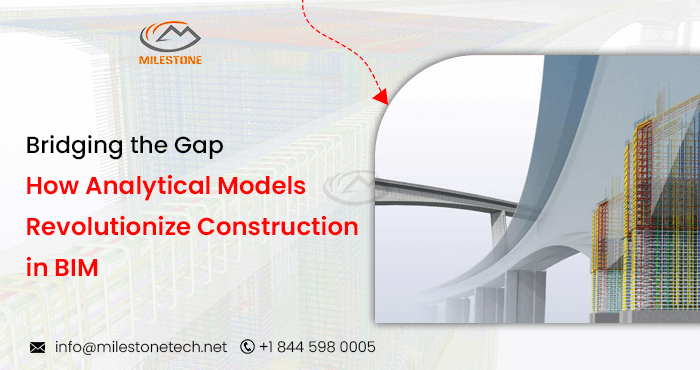Bridging the Gap: How Analytical Models Revolutionise Construction in BIM
[edit] Introduction
In the dynamic landscape of construction services, the integration of Building Information Modeling (BIM) has significantly transformed the way projects are conceived, planned, and executed. One of the key elements driving this transformation is the advent of analytical models. This article explores the role of analytical models in revolutionising construction within the realm of BIM, bridging gaps and enhancing efficiency across the entire project lifecycle.

[edit] Understanding Analytical Models
Analytical models in the context of BIM refer to sophisticated digital representations that simulate the behaviour of a structure under various conditions. Unlike traditional 3D models, analytical models delve deeper into the physics of a building, providing valuable insights into structural performance, energy efficiency, and overall functionality.
[edit] Enhancing Structural Performance
One of the primary advantages of analytical models is their ability to simulate and analyse structural performance. Engineers can assess the impact of different design choices on a building's stability and integrity. This not only reduces the likelihood of structural failures but also allows for optimisation of materials and resources, leading to cost-effective and sustainable construction practices.
[edit] Energy Efficiency and Environmental Sustainability
Analytical models play a pivotal role in promoting energy efficiency and environmental sustainability in construction projects. By simulating the energy performance of a building, stakeholders can make informed decisions regarding insulation, HVAC systems, and other factors influencing energy consumption. This not only aligns with the growing emphasis on green construction but also helps in achieving regulatory compliance and certifications.
[edit] Optimising Project Scheduling and Budgeting
Construction projects are notorious for their complexity, often involving numerous stakeholders, intricate timelines, and tight budgets. Analytical models assist in optimising project scheduling and budgeting by providing accurate data on resource allocation, potential bottlenecks, and critical paths. This foresight enables project managers to make informed decisions, preventing delays and cost overruns.
[edit] Risk Mitigation
Uncertainties are inherent in construction projects, ranging from unexpected weather conditions to unforeseen site challenges. Analytical models contribute to risk mitigation by conducting simulations that anticipate potential issues. This proactive approach allows project teams to develop contingency plans, reducing the impact of unforeseen circumstances and enhancing overall project resilience.
[edit] Integration with AI Tools
The synergy between analytical models and Artificial Intelligence (AI) tools amplifies their impact on construction projects. AI algorithms can analyse vast datasets generated by analytical models, extracting valuable patterns and insights. This not only accelerates decision-making processes but also enables continuous learning and improvement throughout the project lifecycle.
[edit] Challenges and Future Outlook
While the benefits of analytical models in BIM are undeniable, challenges such as data interoperability, standardisation, and the need for skilled professionals persist. Overcoming these challenges requires collaborative efforts from industry stakeholders, policymakers, and educational institutions.
Looking ahead, the integration of analytical models is poised to become even more integral to construction services. Advancements in AI, machine learning, and data analytics will further refine these models, ushering in an era of unprecedented efficiency, sustainability, and innovation in the built environment.
[edit] Conclusion
In conclusion, analytical models are at the forefront of revolutionising construction within the realm of BIM. From enhancing structural performance to optimising project scheduling and budgeting, these models are instrumental in bridging gaps and addressing challenges in the construction industry. As technology continues to evolve, embracing the power of analytical models is not just a choice but a necessity for those aiming to stay competitive and resilient in the ever-changing landscape of engineering and BIM services.
--Engineering Design & BIM Services
[edit] Related articles on Designing Buildings
- As-built drawings and record drawings.
- Asset information model.
- Benefits of manufacturer-created BIM models.
- BIM dimensions, maturity and levels of development.
- Construction Operations Building Information Exchange (COBie).
- CIC BIM Protocol.
- Common data environment.
- Component drawing.
- Design drawings.
- Detail drawing.
- General arrangement drawing.
- Industry Foundation Classes.
- Open data.
- PAS 1192-2:2013.
- PAS 1192-3:2014.
- Production drawing.
- Project information model.
- Shop drawings.
- Symbols on architectural drawings.
- Technical drawing.
- Types of building models.
- Types of drawings for building design.
- Types of paper.
- Types of projection.
- Visualisation.
BIM Directory
[edit] Building Information Modelling (BIM)
[edit] Information Requirements
Employer's Information Requirements (EIR)
Organisational Information Requirements (OIR)
Asset Information Requirements (AIR)
[edit] Information Models
Project Information Model (PIM)
[edit] Collaborative Practices
Industry Foundation Classes (IFC)






